Farming for Native Bees:
Seeking a Solution to the Honey Bee Crisis

Farmer Al from Frog Hollow examines his native bees.
Farming for Native Bees was an innovative, farmer-initiated project addressing a key issue faced by US farmers: the precipitous decline of honey bee pollinators.
The Honey Bee Crisis
California’s almond economy provides a vivid example of the crisis facing farmers across the U.S. California supplies almost 100% of the country’s almonds, and over 80% worldwide. Currently, 1 million hives are imported from as far away as Hawaii and Australia to the Central Valley to pollinate almonds, dramatically increasing production costs and threatening farmers with crop loss. Colony Collapse Disorder, the principal factor affecting honey bees, is still poorly understood and continues to impact hives (USDA CCD Progress Report, 2010). Recent research has explored the potential of some native bee species to supplement honey bees, and several species are now actively managed for this purpose (Bosch et al, 2006). However, while these native species may alleviate the immediate crisis, they do not resolve the underlying problems resulting from dependence on one or two species for crop pollination.
Recent research has shown that native bees are crucial to long-term agricultural resilience and sustainability. Yet, most farmers are unaware of the important role of native bees in agriculture, much less how to harness their services to guard against honey bee declines.
Recent research has shown that native bees are crucial to long-term agricultural resilience and sustainability. Yet, most farmers are unaware of the important role of native bees in agriculture, much less how to harness their services to guard against honey bee declines.
Farming for Native Bees

Dwelley Farm bee plantings.
Based on 12 years of groundbreaking research in urban gardens, Farming for Native Bees partnered with 8 small farmers in Brentwood, California, the UC Cooperative Extension, and the USDA-Natural Resources Conservation Service to construct on-site native bee habitat. The project’s overarching goals were to:
· Provide farmers with a stable, cost-effective and sustainable supplement of native bees to honey bees
· Establish new habitats that will work to conserve and protect California’s native bees
· Form partnerships with farmers to implement native bee habitats and monitor native bees in California agricultural areas
Combining on-the-ground restoration, sound scientific research, economic analysis and targeted, hands-on outreach and education, Farming for Native Bees promises to contribute important new insights on the role native bees in agriculture, and engage farmers in their conservation.
In 2014 and 2015, we laid the foundations for expanding this work to avocado farms in Ventura County, and as of 2016 we began to conduct research in Ventura.
Collections for the study concluded in 2022, and data is in the process of analysis.
· Provide farmers with a stable, cost-effective and sustainable supplement of native bees to honey bees
· Establish new habitats that will work to conserve and protect California’s native bees
· Form partnerships with farmers to implement native bee habitats and monitor native bees in California agricultural areas
Combining on-the-ground restoration, sound scientific research, economic analysis and targeted, hands-on outreach and education, Farming for Native Bees promises to contribute important new insights on the role native bees in agriculture, and engage farmers in their conservation.
In 2014 and 2015, we laid the foundations for expanding this work to avocado farms in Ventura County, and as of 2016 we began to conduct research in Ventura.
Collections for the study concluded in 2022, and data is in the process of analysis.
